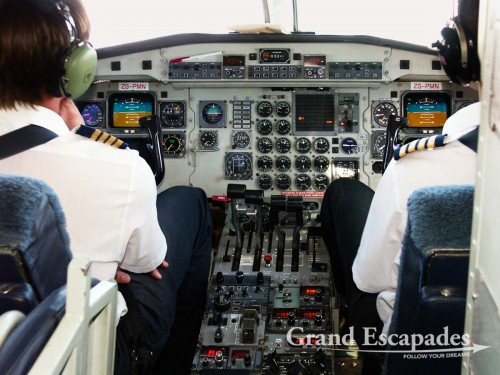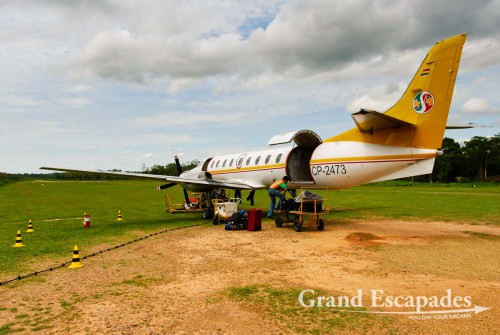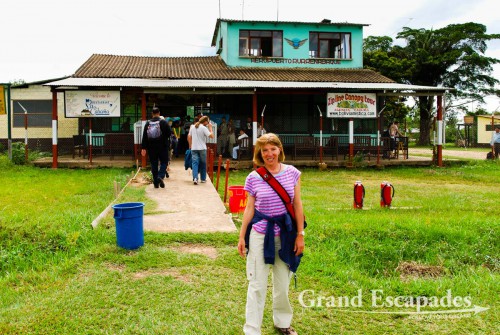This chapter is aimed at persons who are VERY interested in traveling by plane or flying planes. Only if this is the case, read on… Flying in South America is something really special, we will soon explain why. But without any doubt, the climax is La Paz El Alto (IATA: LPB / ICAO: SLLP), the highest international airport and the second highest commercial airport in the world at 13.325 feet or 4.061 meters (the highest one is “Qamdo Bangda” in Tibet at 14.219 feet or 4.334 meters, but is hardly known).
At this high altitude, the air is “thin” and therefore “carries” much less than at sea level. On top of that, La Paz is close to the Equator and therefore, even given the high altitude, the air is comparatively warm. That means the air “carries” even less, La Paz El Alto is indeed the very “High & Hot” airport in the world. And that makes it an exciting place to fly at!
A plane must approach much faster (5 to 10 Knots Indicated Air Speed or KIAS) than normally, having a landing speed almost equal to its starting speed! But that is not all: the airport’s runway 10 is equipped with an ILS Cat 2 Approach, which enables an automatic approach until 400 feet Above Ground Level (A.G.L.). But its opposite end, runway 28, only allows a VOR or “Non Precision Approach”, with a 90 degrees left turn only 4.5 N.M. (nautical miles) of the runway, making it a “Kai Tak – like approach”. And talking about the runway, it measures no less than 13.325 feet or 4.000 meters and is therefore one of the longest runways in the world (ok, not as long as the one for the Space Shuttles in Cape Canaveral …).
But the most interesting part is definitely taking off … As already mentioned, this airport is “High & Hot” and therefore the wings “carry” less than at sea level. On top of that, the engines’ efficiency is lower at this altitude and with these higher temperatures, therefore acceleration and of course take-off times are even longer. As a consequence, a plane needs up to 50% more runway to start than at “Mean Sea Level” and is not able to climb as fast as at “Mean Sea Level”.
And that is what we experienced …
On our two flights from La Paz to Rurrenabaque, the time rolling (on the runway from complete stop to rotation and take-off) on a small Fairchild Metro SA-227 was 46 second the first time (cold and rainy) and 53 seconds the second time. We also measured a time rolling of 62 seconds for a Boeing 727! And we had the “chance” to experience twice an approach on runway 28, as spectacular as described above! The approach speed was also incredible. The captain told us afterwards that he approaches between 115 and 117 KIAS where he takes off (V.R.) with 122 KIAS. Note that the true airspeed is almost twice as high as at see level, though…
Because of these specific conditions, La Paz is THE place where every aircraft is tested under “High & Hot” conditions to get certified for commercial flights. We saw the brand new Falcon 7X, which Gilles saw at the Paris Air Show in Le Bourget in June 2007, being tested. And the captain of our flight to Rurrenabaque told us that the Airbus A380 was planed to be tested in La Paz, but the A.P.U. (Auxiliary Power Unit, which, among others, starts the engines) would have needed to be redesigned just for La Paz. So Airbus did the tests in Addis Ababa in Ethiopia instead … at “only” 7.800 feet.
But La Paz was not the only “interesting experience” we have had when flying in South America … The airport in Rurrenabaque was quite an experience, with its grass runway that cannot be used when it rains, leading to numerous flight cancellations, we have mentioned it before. We also enjoyed a pilot reading his newspaper on a small Cessna on the way to Canaima in Venezuela…
Surely another surprise was the way how Brazilian pilots behave during take-off and landing. For take-off, they never seem to hesitate to use full power: we experienced take-off times of 26 seconds on a full Airbus A320! As for landing, they bring the plane to a stop so abruptly that passengers are thrown forward, among others using reverse thrust at full power until complete stop!
But the most unbelievable for someone used to flying in Europe or the USA, where pilots stabilize planes on the localizer for 15 to 20 N.M., is the habit of Latin American pilots to make an extremely sharp turn, ranging from 90 to 200 degrees and immediately touch down afterwards. We experienced it on small Cessnas, where it surprised us a lot. But we also experienced it on Airbus A320 or Boeing 737, which are no small planes. And that is a weird feeling!




No comments yet.